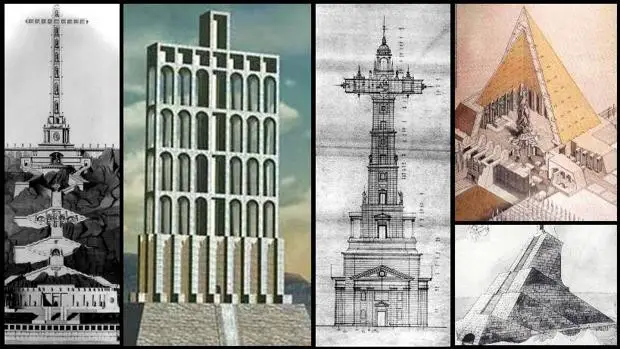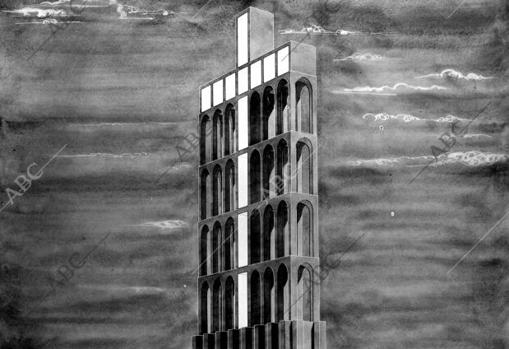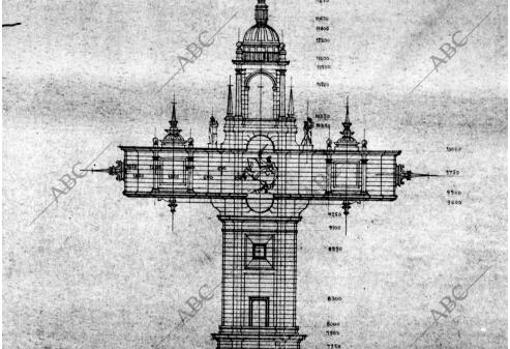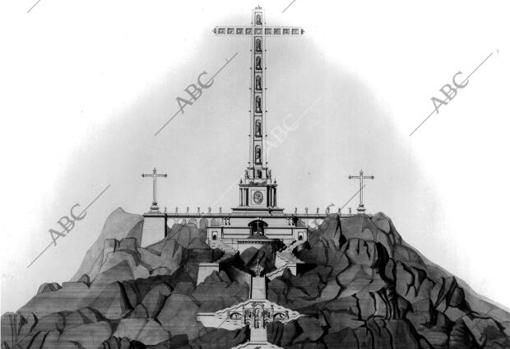 The five designs for the Valley of the Fallen and its cross that were considered before the final project – ABCIsrael VianaMadridUpdated: 18/11/2022 00:19h
The five designs for the Valley of the Fallen and its cross that were considered before the final project – ABCIsrael VianaMadridUpdated: 18/11/2022 00:19h
"La Cruz was our nightmare," ABC acknowledged, in 1957, the architect responsible for the Valley of the Fallen: Diego Méndez. He was talking about the gigantic and controversial commemorative monument that Isabel Díaz Ayuso is trying to protect by law, more than sixty years after its inauguration, according to what sources from the regional government have told this newspaper. More than 200.000 tons of concrete and cement, 150 meters high from the base and 46 meters long at its arms, which the president of the Community of Madrid wants to shield "against any attempted aggression."
Ayuso will do so through the project of the new regional Heritage Law, which establishes the possibility of preserving, following technical criteria, the Cruz fame and the decorative elements linked to religious architecture, as long as the relevant technicians deem it so.
The Madrid president has made a move in this regard, despite the fact that, three years ago, the Prime Minister, Pedro Sánchez, stated that he had "no problem" with it and that he was not contemplating its demolition.
Controversy, however, has surrounded this monument and the Valley of the Fallen since the arrival of democracy, as evidenced by the exhumations of Franco and José Antonio Primo de Rivera. In November 2010, for example, the Forum for the Memory of the Community of Madrid and the Social Forum of the Sierra de Guadarrama called for its immediate blowing up: revenge”, they argued.
"Both for Franco and for me, it was a nightmare to present a Cross at the top of the cliff that climbed up to the clouds without appearing dwarf or vulgar in style and proportions," Mendes, who had been a National Heritage Architecture adviser, pointed out in 1957. for the dictator. A freighter from which, in addition to the works in the Valley of the Fallen, he led the reconstruction of the Palacio de La Granja, La Moncloa, the Palacio de la Zarzuela, the Reales Alcázares in Seville, the Monastery of El Escorial and the Monastery of Las Descalzas de Madrid, among other historical buildings.
 More information
More information
Futuristic and extravagant models
The Madrid architect recorded on ABC the contest that the regime opened, in 1950, for anyone who wanted to present their proposal for the great cross that was to crown the Valley of the Fallen. Several models arrived that this newspaper keeps in its archive. Some of them were much larger than what they finally turned out to be, others seemed taken from a science fiction movie, like Francisco Cabrero's, which seemed trapped in the future. Some as rare as that of Víctor d'Ors. Prestigious architects such as Pedro Muguruza and the team made up of Luis Moya, Enrique Huidobro and Manuel Thomas also presented their most impressive and classic projects.
Many of these funerary monuments would have been too small if the majesty concrete pyramid designed in 1940 for the Viscount of Uzqueta, the architect Luis Moya and the sculptor Manuel Laviada had been chosen, which they wanted to locate in the center of Madrid and not in San Lorenzo from El Escorial. As the researcher and historical disseminator José Luis Hernández Garvi, author of 'Occultism and esoteric mysteries of Francoism' (Luciérnaga, 2017), pointed out to ABC a year ago, "it was larger than that of Keops and a large avenue led from it four lanes in each direction, which recalled the megalomaniac ideas of Hitler and his architect, Albert Speer”.
Méndez did not appear in the contest "out of elemental delicacy." Since he knew charge, the inappropriate seemed. However, Franco did not like any of those futuristic and extravagant designers. The dictator declared it void and asked the architect to finally take charge of the work personally. He had to crown the underground basilica with an enduring symbol and he had to have it as soon as possible: “Months went by and he couldn't find the solution. One day, unexpectedly, while I was waiting for my five children to get dressed to go to mass, absorbed, almost enlightened, almost a passive instrument, pencil in hand with which I was making arabesques on paper, I inadvertently drew the Cross. just as it is now nailed to the mighty elevation.”
 + infoProject by Pedro Muguruza for the Cross of the Fence of the Fallen – ABC
+ infoProject by Pedro Muguruza for the Cross of the Fence of the Fallen – ABC
“Not a single accident”
Thus, in July 1950 the foundation began and, in 1951, the construction of the cross. Everything was done at a fast pace in which, according to ABC, more than 2.000 workers participated. Among them were "eighty convicted," Méndez said. From what was later learned, many of them were Republican prisoners from the Civil War who ended up dying during the works and being buried under those stones. The defenders of the monument allege that from the beginning it was planted as a resting place for the dead of both sides in the war and that there is no support for the claim that almost 27.000 political prisoners died in its construction.
“It is an absurd number. Where are those families? 2.500 prisoners participated in the construction, who could circulate freely because they ignited pain with days of work. There were no more than ten deaths in 18 years of works”, said the senator to the BBC, in 2010, the senator of the Popular Party Juan Van-Halen. Some opposing sources speak of several dozen, but the real number was never known. Méndez, for his part, assured: “The workers drilled holes in the granite, climbed onto improbable scaffolding and handled dynamite. They played with death day by day and triumphed over it. During the construction of the cross, a single accident was recorded.
In April 2018, four families managed to win the legal battle and against Patrimony that prevented them from recovering the remains of their relatives, who died in the Civil War and were buried as a tribute in the ossuary in the crypt of the tomb, beyond the workers who died in the works. They were two Republicans and two Francoists, included in the 33.815 querpos that are there, of which 36% (12.410) remain unidentified. The list of all is public on the website of the Ministry of the Interior, except that the information is limited to the numbers called and has a known origin.
 + infoProject by Luis Moya, Enrique Huidobro and Manuel Thomas for the Cruz del Valle de los Caídos – ABC
+ infoProject by Luis Moya, Enrique Huidobro and Manuel Thomas for the Cruz del Valle de los Caídos – ABC
the oscillation
Méndez told ABC in 1957, shortly after the inauguration of the Valley of the Fallen, that at the top of the cross one could notice a sensitive oscillation in addition to the arms, wisely studied, where, as also described by the guides tourist, "Two cars can cross without touching." Beyond this publicity, its dimensions allow it to accommodate a spiral staircase and an elevator from the base to the arms. And that the four Evangelists of Juan de Ávalos, measuring 18 meters each, be stationed at its base.
The works of the Cross and the basilica finished in 1958, seeing fulfilled the dream that the Caudillo reflected, in 1940, in the Official State Gazette: "It is necessary that the stones that are raised have the grandeur of the ancient monuments, that they challenge time and oblivion and that constitute a place of meditation and rest for future generations to pay homage to those who bequeathed them a better Spain”.
According to the author of the interview with Méndez, Tomás Borrás, foreigners saw the construction differently: “Latinos understand it; the Anglo-Saxons, no. They ask what is their profitability. I answer them 'none'. And they are astounded by both the work itself and what they call 'its uselessness'”. For the writer and journalist from Madrid, however, "a case of genius in filmmakers" was used.
